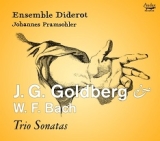Obwohl er ein Schüler von Johann Sebastian Bach war und zu dessen besten zählte, ist Johann Gottlieb Goldberg kaum bekannt. Allenfalls mögen die möglicherweise für ihn als Übungsstücke komponierten Variationen, die seinen Namen tragen, einen Ausruf des Erkennens auslösen. Vielleicht wurde Goldberg, der nicht einmal dreißig Jahre alt wurde, übersehen, weil er in seinen Kompositionen vielfach noch am barocken Stil festhielt, als schon die Vorklassik sich ihren Weg bahnte. Doch auch Elemente der neuen leichteren Musik finden sich bei ihm, wie man aus den vier hier gezeigte Triosonaten heraushören kann.
Doch allein das Format der Triosonate weist schon wieder auf Bach und den Barock zurück, wenn es Goldberg hier auch, etwa in der g-Moll Sonate mit Dreisätzigkeit und galantem Stil aufweicht. Einen strengen Kanon in den Melodiestimmen über einer freien Bassstimme im dritten Satz der C-Dur Sonate oder eine alte Form, die Chaconne mit raffinierten Imitationen und Kanons im Schlusssatz der B-Dur Sonate zeigen Bach als Vorbild und enge Verbindung.
Wenn auch das Ensemble Diderot hier einmal keine Ersteinspielungen vorliegt, so bieten sie immerhin erneut wenig Gespieltes an. In der Melange zwischen Barock und galantem Stil wissen sie ihre spieltechnisch ausgereiften Fähigkeiten so einzusetzen, dass sie die Werke zupackend, lebendig und ausdrucksstark zu gestalten. Und so leben in ihren Deutungen beide Stilwelten detailreich auf.
Although he was a pupil of Johann Sebastian Bach and one of his best, Johann Gottlieb Goldberg is hardly known. At best, the variations bearing his name, possibly composed for him as practice pieces, may elicit an exclamation of recognition. Perhaps Goldberg, who died when he was not even thirty years old, was overlooked because he still adhered to the baroque style in many of his compositions at a time when pre-classical music was already making its way. But elements of the new, lighter music can also be found in his works, as can be heard in the four trio sonatas shown here.
But the format of the trio sonata alone already points back to Bach and the Baroque, even if Goldberg softens it here, for example in the G minor sonata with its three movements and gallant style. A strict canon in the melody parts over a free bass part in the third movement of the C major sonata or an old form, the chaconne with refined imitations and canons in the final movement of the B flat major sonata show Bach as a model and close connection.
Even if the Ensemble Diderot does not present any first recordings here, they still offer something that has not been played very often. In the melange between baroque and galant style, they know how to use their technically mature playing skills to give the works a gripping, lively and expressive form. And so their interpretations bring both stylistic worlds to life in rich detail.






















